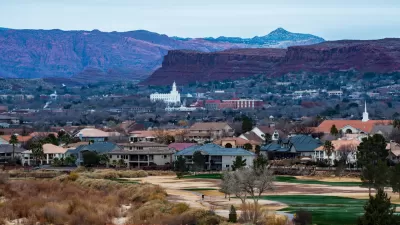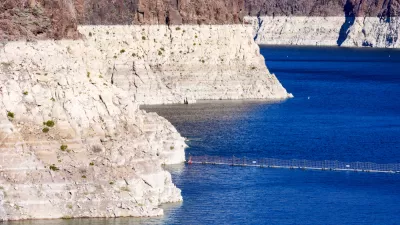Amid a growing water crisis, more cities are cracking down on ornamental uses of grass and golf course greens.

As water in the Southwest becomes an increasingly scarce resource, cities with high water usage are being forced to rethink their priorities. In St. George, Utah, one of the fastest-growing cities in the country, golf has long been one of those priorities, writes Samuel Shaw in High Country News.
As Shaw explains, “St. George’s water rates are among the lowest in the West, which results in bigger profits for course operators and more affordable green fees, but also disincentivizes conservation.” And keeping golf courses green year round in the hot, arid desert environment takes around 177 million gallons of water per year for each course—“roughly eight times the national average.”
The popularity of golf in the area and historically low water costs are taking their toll. “Few cities in the Southwest use more water per person: nearly 300 gallons a day. And a hefty portion of that, over half, goes to keeping ornamental grass, lawns and golf courses lush in an arid region where water supplies are dwindling every day.”
But the tide may be turning against the sacrosanct sport and the wasteful use of water: “In 2022, the city of Ivins, an exurb of St. George, effectively banned the construction of new golf courses, while early this year, state Rep. Douglas Welton, R, introduced House Bill 188, which could require golf courses to be more transparent about how much water they use.” For now, the city has passed new water conservation ordinances. Elsewhere in the Southwest, Las Vegas passed some of the strictest conservation measures, targeting ornamental uses and golf courses.
FULL STORY: In the Utah desert, can golf justify itself?

Study: Maui’s Plan to Convert Vacation Rentals to Long-Term Housing Could Cause Nearly $1 Billion Economic Loss
The plan would reduce visitor accommodation by 25,% resulting in 1,900 jobs lost.

North Texas Transit Leaders Tout Benefits of TOD for Growing Region
At a summit focused on transit-oriented development, policymakers discussed how North Texas’ expanded light rail system can serve as a tool for economic growth.

Why Should We Subsidize Public Transportation?
Many public transit agencies face financial stress due to rising costs, declining fare revenue, and declining subsidies. Transit advocates must provide a strong business case for increasing public transit funding.

A Visual Celebration of Manhattan’s Chinatown Elder Community, Through Food
Lanterns, cafeteria trays, and community connection take center stage in this stunning photo essay.

How to Make US Trains Faster
Changes to boarding platforms and a switch to electric trains could improve U.S. passenger rail service without the added cost of high-speed rail.

Columbia’s Revitalized ‘Loop’ Is a Hub for Local Entrepreneurs
A focus on small businesses is helping a commercial corridor in Columbia, Missouri thrive.
Urban Design for Planners 1: Software Tools
This six-course series explores essential urban design concepts using open source software and equips planners with the tools they need to participate fully in the urban design process.
Planning for Universal Design
Learn the tools for implementing Universal Design in planning regulations.
City of Santa Clarita
Ascent Environmental
Institute for Housing and Urban Development Studies (IHS)
City of Grandview
Harvard GSD Executive Education
Toledo-Lucas County Plan Commissions
Salt Lake City
NYU Wagner Graduate School of Public Service





























